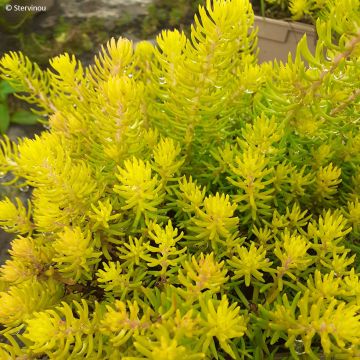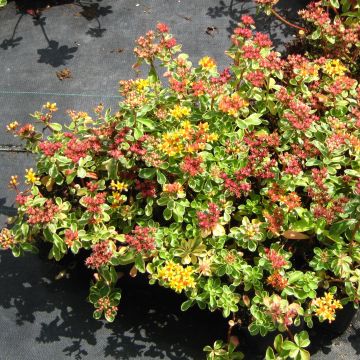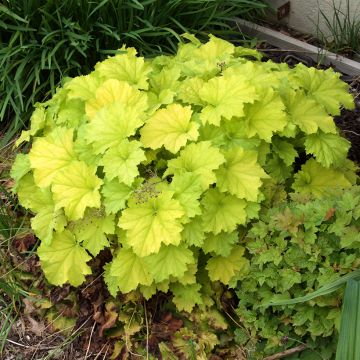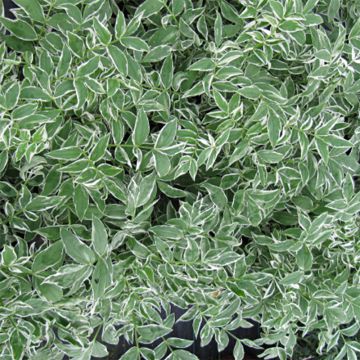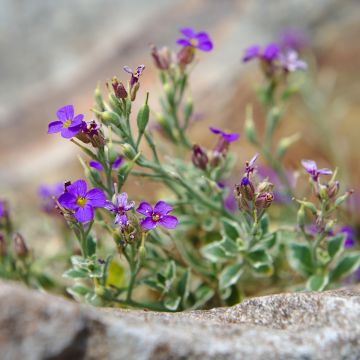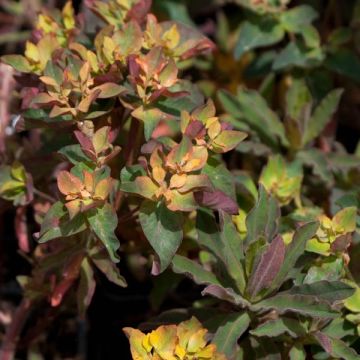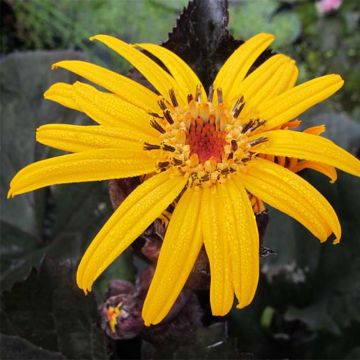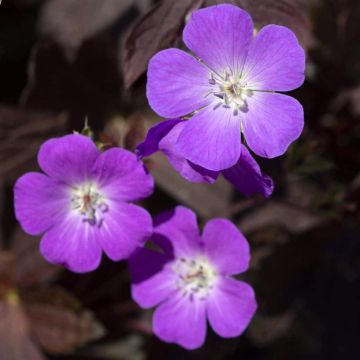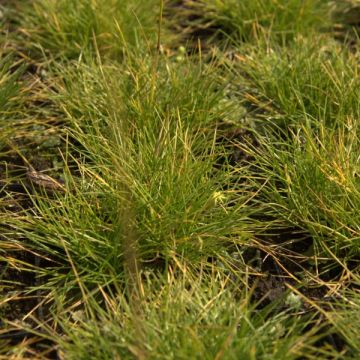

Hylotelephium telephium Class Act - Stonecrop
Hylotelephium telephium Class Act - Stonecrop
Hylotelephium (x) telephium Class Act
Orpine, Live-forever, Witch's Moneybags
Why not try an alternative variety in stock?
View all →This plant carries a 12 months recovery warranty
More information
We guarantee the quality of our plants for a full growing cycle, and will replace at our expense any plant that fails to recover under normal climatic and planting conditions.
From €5.90 for pickup delivery and €6.90 for home delivery
Express home delivery from €8.90.


Does this plant fit my garden?
Set up your Plantfit profile →
Description
The Sedum or Hylotelephium 'Class Act' is a variety of autumn stonecrop of great class, awarded many times, notably by the R.H.S in England. The plant is characterized by a naturally compact habit, early flowering, and large inflorescences intensely coloured in red-pink. They bloom in great numbers from late August, at the end of multiple sturdy stems adorned with green foliage. The flowering period is long and highly visited by butterflies. It is a carefree perennial, ideal for rock gardens and flowering pots.
The 'Class Act' Autumn Stonecrop belongs to the Crassulaceae family. It is a horticultural hybrid derived from Sedum telephium, now renamed Hylotelephium telephium, originating from the Caucasus and China. This cultivar 'Class Act' forms well-bushy clumps, which hold well, with a rounded habit, reaching approximately 45cm in height and 50cm in width. The flowering begins in August-September, more or less early depending on the climate. The inflorescences, in rounded terminal cymes, are very dense and reach 11cm in diameter. The tiny star-shaped flowers open in dark red, then evolve to bright purplish pink and fade to a lighter pink. They form the false umbels that are intensely nectariferous and melliferous. The stems of this sedum are slightly brownish. The deciduous, thick and fleshy foliage is a fairly vibrant green and harmonizes beautifully with the flowering. The leaves are flat and ovate, with large rounded teeth on the upper half. The vegetation, deciduous, emerges from the ground in spring and dries out in autumn.
A boon for areas in the garden where the soil is thin, the 'Class Act' Sedum is a very good plant for dry soil. It thrives in rock gardens and sunny borders, as well as in large pots. In the garden, combine it with ornamental grasses for dry soil and grey-leaved plants that accept, like it, these difficult living conditions (Stipa tenuifolia, Tanacetum haradjanii...). You will create an original scene by associating it with 'Little Carlow' heart-leaved asters or Nepeta 'Cat's Pyjamas'. Magnificent in its graphic design as a potted plant, it is also an excellent flower for drying or for bouquets.
Report an error about the product description
Flowering
Foliage
Plant habit
Botanical data
Hylotelephium
(x) telephium
Class Act
Crassulaceae
Orpine, Live-forever, Witch's Moneybags
Sedum 'Class Act'
Cultivar or hybrid
Other Sedum
Planting and care
Plant Sedum 'Class Act' in soil that is not too rich, even limestone and dry, but absolutely well-drained to protect the roots from cold winter moisture. It tolerates clayey soils in regions with dry winters. Excessive fertilization can distort this variety. Plant it in full sun to enhance flowering. This plant is very hardy and requires no watering once established in the ground. In pots, provide a layer of gravel for drainage and water regularly. Cut back the clump in winter when it is dry. Divide the plant after 3 to 4 years to encourage vigorous growth and prevent it from thinning out in the centre and the side stems from collapsing onto the ground. Sedums are very easy to propagate, in spring, cut a stem or even a leaf that you leave for a few days in a dry and shady place so that they dry out a little, then place them in a tray of moist sand.
Planting period
Intended location
Care
This item has not been reviewed yet - be the first to leave a review about it.
Coloured foliage perennials
Haven't found what you were looking for?
Hardiness is the lowest winter temperature a plant can endure without suffering serious damage or even dying. However, hardiness is affected by location (a sheltered area, such as a patio), protection (winter cover) and soil type (hardiness is improved by well-drained soil).

Photo Sharing Terms & Conditions
In order to encourage gardeners to interact and share their experiences, Promesse de fleurs offers various media enabling content to be uploaded onto its Site - in particular via the ‘Photo sharing’ module.
The User agrees to refrain from:
- Posting any content that is illegal, prejudicial, insulting, racist, inciteful to hatred, revisionist, contrary to public decency, that infringes on privacy or on the privacy rights of third parties, in particular the publicity rights of persons and goods, intellectual property rights, or the right to privacy.
- Submitting content on behalf of a third party;
- Impersonate the identity of a third party and/or publish any personal information about a third party;
In general, the User undertakes to refrain from any unethical behaviour.
All Content (in particular text, comments, files, images, photos, videos, creative works, etc.), which may be subject to property or intellectual property rights, image or other private rights, shall remain the property of the User, subject to the limited rights granted by the terms of the licence granted by Promesse de fleurs as stated below. Users are at liberty to publish or not to publish such Content on the Site, notably via the ‘Photo Sharing’ facility, and accept that this Content shall be made public and freely accessible, notably on the Internet.
Users further acknowledge, undertake to have ,and guarantee that they hold all necessary rights and permissions to publish such material on the Site, in particular with regard to the legislation in force pertaining to any privacy, property, intellectual property, image, or contractual rights, or rights of any other nature. By publishing such Content on the Site, Users acknowledge accepting full liability as publishers of the Content within the meaning of the law, and grant Promesse de fleurs, free of charge, an inclusive, worldwide licence for the said Content for the entire duration of its publication, including all reproduction, representation, up/downloading, displaying, performing, transmission, and storage rights.
Users also grant permission for their name to be linked to the Content and accept that this link may not always be made available.
By engaging in posting material, Users consent to their Content becoming automatically accessible on the Internet, in particular on other sites and/or blogs and/or web pages of the Promesse de fleurs site, including in particular social pages and the Promesse de fleurs catalogue.
Users may secure the removal of entrusted content free of charge by issuing a simple request via our contact form.
The flowering period indicated on our website applies to countries and regions located in USDA zone 8 (France, the United Kingdom, Ireland, the Netherlands, etc.)
It will vary according to where you live:
- In zones 9 to 10 (Italy, Spain, Greece, etc.), flowering will occur about 2 to 4 weeks earlier.
- In zones 6 to 7 (Germany, Poland, Slovenia, and lower mountainous regions), flowering will be delayed by 2 to 3 weeks.
- In zone 5 (Central Europe, Scandinavia), blooming will be delayed by 3 to 5 weeks.
In temperate climates, pruning of spring-flowering shrubs (forsythia, spireas, etc.) should be done just after flowering.
Pruning of summer-flowering shrubs (Indian Lilac, Perovskia, etc.) can be done in winter or spring.
In cold regions as well as with frost-sensitive plants, avoid pruning too early when severe frosts may still occur.
The planting period indicated on our website applies to countries and regions located in USDA zone 8 (France, United Kingdom, Ireland, Netherlands).
It will vary according to where you live:
- In Mediterranean zones (Marseille, Madrid, Milan, etc.), autumn and winter are the best planting periods.
- In continental zones (Strasbourg, Munich, Vienna, etc.), delay planting by 2 to 3 weeks in spring and bring it forward by 2 to 4 weeks in autumn.
- In mountainous regions (the Alps, Pyrenees, Carpathians, etc.), it is best to plant in late spring (May-June) or late summer (August-September).
The harvesting period indicated on our website applies to countries and regions in USDA zone 8 (France, England, Ireland, the Netherlands).
In colder areas (Scandinavia, Poland, Austria...) fruit and vegetable harvests are likely to be delayed by 3-4 weeks.
In warmer areas (Italy, Spain, Greece, etc.), harvesting will probably take place earlier, depending on weather conditions.
The sowing periods indicated on our website apply to countries and regions within USDA Zone 8 (France, UK, Ireland, Netherlands).
In colder areas (Scandinavia, Poland, Austria...), delay any outdoor sowing by 3-4 weeks, or sow under glass.
In warmer climes (Italy, Spain, Greece, etc.), bring outdoor sowing forward by a few weeks.





































